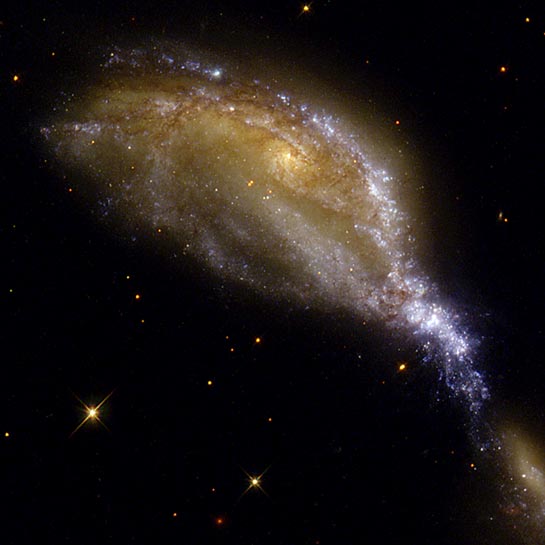
Interacting Galaxy
R.A. 19h 01m 41.79s Dec. 40° 44' 44.6"
Lyra
13.3
Roughly 1.5 x 0.7 arcminutes with a major axis of roughly 26 kpc
About 63.5 Mpc (206 million light-years)
WFPC2
March 18 - 21, 1996
10.3 hours
Red: F814W (I), Green F555W (V), Blue F336W (U)
NASA and The Hubble Heritage Team (STScI/AURA)
November 2, 2000 1:00 a.m. (EST)
ABOUT THIS IMAGE:
What appears as a bird's head, leaning over to snatch up a tasty meal, is a striking example of a galaxy collision in NGC 6745. A large spiral galaxy, with its nucleus still intact, peers at the smaller passing galaxy (nearly out of the field of view at lower right), while a bright blue beak and bright whitish-blue top feathers show the distinct path taken during the smaller galaxy's journey. These galaxies did not merely interact gravitationally as they passed one another, they actually collided.
When galaxies collide, the stars that normally comprise the major portion of the luminous mass of each of the two galaxies will almost never collide with each other, but will pass rather freely between each other with little damage. This occurs because the physical size of individual stars is tiny compared to their typical separations, making the chance of physical encounter relatively small. In our own Milky Way galaxy, the space between our Sun and our nearest stellar neighbor, Proxima Centauri (part of the Alpha Centauri triple system), is a vast 4.3 light-years.
However, the situation is quite different for the interstellar media in the above two galaxies - material consisting largely of clouds of atomic and molecular gases and of tiny particles of matter and dust, strongly coupled to the gas. Wherever the interstellar clouds of the two galaxies collide, they do not freely move past each other without interruption but, rather, suffer a damaging collision. High relative velocities cause ram pressures at the surface of contact between the interacting interstellar clouds. This pressure, in turn, produces material densities sufficiently extreme as to trigger star formation through gravitational collapse. The hot blue stars in this image are evidence of this star formation.
This
image was created by the Hubble Heritage Team using NASA Hubble Space
Telescope archive data taken with the Wide Field Planetary Camera 2 in
March 1996. Members of the science team, which include Roger Lynds (KPNO/NOAO)
and Earl J. O'Neil, Jr. (Steward Obs.), used infrared, red, visual and
ultravoilet filters to image this galaxy system. Lynds and O'Neil are
currently using the Hubble data along with ground-based radio observations
to further study the interactions within NGC 6745